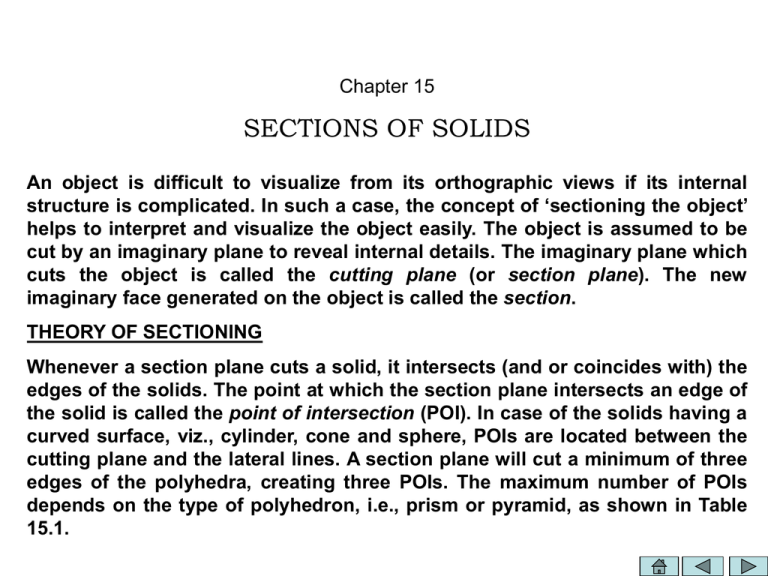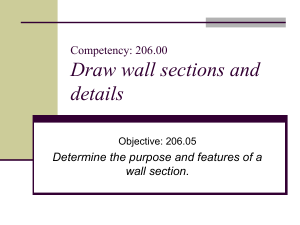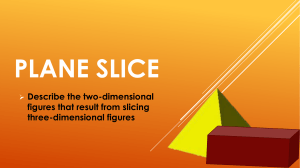Slide 1 - Weebly
advertisement

Chapter 15 SECTIONS OF SOLIDS An object is difficult to visualize from its orthographic views if its internal structure is complicated. In such a case, the concept of ‘sectioning the object’ helps to interpret and visualize the object easily. The object is assumed to be cut by an imaginary plane to reveal internal details. The imaginary plane which cuts the object is called the cutting plane (or section plane). The new imaginary face generated on the object is called the section. THEORY OF SECTIONING Whenever a section plane cuts a solid, it intersects (and or coincides with) the edges of the solids. The point at which the section plane intersects an edge of the solid is called the point of intersection (POI). In case of the solids having a curved surface, viz., cylinder, cone and sphere, POIs are located between the cutting plane and the lateral lines. A section plane will cut a minimum of three edges of the polyhedra, creating three POIs. The maximum number of POIs depends on the type of polyhedron, i.e., prism or pyramid, as shown in Table 15.1. True Shape of a Section A section will show its true shape when viewed in normal direction. Obviously, to find the true shape of a section, it must be projected on a plane parallel to the section plane. For polyhedra, the true shape of the section depends on the number of POIs. The shape of the section will be a polygon of the sides equal to the number of POIs. The true shape of the section of a sphere is always a circle. The sections of prisms and pyramids are straight line segmented curves. The sections of cylinders and cones will mostly have smooth curves. The true shapes of the sections of the cylinder and cone, depending on the position of the cutting plane, are explained in Table 15.2. Locating the Section Plane When the True Shape of the Section is Known Locating the section plane when the true shape of the section is given is a reverse process. For polyhedra, the cutting plane must cut the solid at the points equal to the number of corners in the section. For example, if the true shape of a section of a cube is a hexagon, then the cutting plane must create 6 POIs in FV or TV. To locate the cutting plane, it is a usual practice to draw the true shape of the section in auxiliary view and then, projecting all the corners in FV or TV. SECTIONS OF PRIMS AND CUBES Example 15.1 A triangular prism with a base side of 50 mm and an axis length of 70 mm is resting on its rectangular face on the HP with the axis perpendicular to the VP. The prism is cut by a horizontal section plane passing through the axis. Draw FV and sectional TV of the prism. Solution Refer Fig. 15.1. 1. Draw FV and TV of the prism as shown. 2. In FV, draw the section plane, parallel to XY and passing through the axis as shown. The direction of the arrowheads should be towards XY (since it is a first angle method of projection). 3. Locate POIs 1’, 2’, 3’ and 4’ in FV. 1’, 2’, 3’ and 4’ represent the intersections of the cutting plane with a’ c’, b’ c’, b1’ c1’ and a1’ c1’ respectively. 4. Project 1’, 2’, 3’ and 4’ to 1, 2, 3 and 4 on the corresponding edges in TV. Join 1–2–3–4 and hatch the area to indicate the section. 1–2–3–4 represents the true shape of the section (since the cutting plane is parallel to XY). Example 15.4 A triangular prism, with a base side of 50 mm and an axis length of 70 mm, is resting on a rectangular face on the HP, the axis being parallel to the VP. An AIP inclined at 45° to the HP cuts the prism. The cutting plane intersects the axis at a distance of 30 mm from one end of the prism. Draw FV, sectional TV and sectional SV of the prism. Solution Refer Fig. 15.4. 1. Draw SV, FV and TV of the prism as shown. 2. In FV, draw the section plane, inclined at 45° to XY and intersecting the axis at 30 mm from an end of the prism, as shown. 3. Locate 1’, 2’ and 3’ in FV at the intersections of the cutting plane with a’ a1’, b’ b1’ and c’ c1’ respectively. 4. Project 1’, 2’ and 3’ to 1, 2 and 3 on corresponding edges in TV. Join 1–2–3 and hatch the section. 5. Obtain section 1”–2”–3” in SV by projecting POIs from FV and TV. 1”, 2” and 3” will obviously lie at a”, b” and c” respectively. Example 15.6 A cube of 50 mm side length rests on an edge on the HP. The edge is parallel to the VP and the two faces sharing the edge are equally inclined to the HP. An AIP, inclined at 47° to the HP and passing through one of the top corners of the cube, cuts the cube. Draw FV, sectional TV and sectional SV. Also, draw the true shape of the section. Solution Refer Fig. 15.6. 1. Draw SV, FV and TV of the cube as shown. 2. In FV, draw the section plane passing through c1’ and inclined at 47° to XY. 3. Locate 1’, 2’, 3’, 4’ and 5’ in FV at the intersections of the cutting plane with the edges. (1’ coincides with c1’.) 4. Project 2’ and 5’ to 2 and 5 on the corresponding edges in TV. Project 1’, 3’ and 4’ to 1”, 3” and 4” on the corresponding edges in SV. (1” coincides with c1”.) 5. Project 1”, 3” and 4” to 1, 3 and 4 in TV. (1 coincides with c1.) Join 1–2–3–4– 5 and hatch the area. 6. Project 2 and 5 to 2” and 5” in SV. (2 and 5 coincide with b” ( b1”) and d” (d1”) respectively.) Join 1”–2”–3”–4”–5” and hatch the area. 7. To draw the true shape of the section, draw X1 Y1 parallel to the cutting plane. Project 1’, 2’, 3’, 4’ and 5’ on X1 Y1 and draw auxiliary view 11–21– 31–41–51. (Distances of 11, 21, 31, 41 and 51 from X1 Y1 = Distances of 1, 2, 3, 4 and 5 from XY.) Example 15.7 A triangular prism with a base side of 50 mm and a 70 mm height stands on its base on the HP with a rectangular face perpendicular to the VP. It is cut by different AIPs such that the true shape of the section is (i) an isosceles triangle of 42 mm base and 38 mm height (ii) an isosceles triangle of maximum size (iii) a trapezium of parallel sides of 50 mm and 22 mm Locate the cutting plane and the draw FV, TV and the true shape of the section in each case. Solution For the true shape of the section to be a triangle, the section plane must cut 3 edges of the prism. Similarly, the section plane must cut 4 edges for the section to be trapezium. Draw TV and FV of the prism as shown in Fig. 15.7. Case (i): True shape: Isosceles triangle of 42 mm base and 38 mm height For the isosceles triangle of given size, the section plane must cut two adjacent edges of the top at points 42 mm apart. The third point can be located on the vertical edge (emerging from the intersection of the two top edges) such that the distance of that point from the line joining the first two points will be equal to the altitude of the triangle. 1. In TV, locate 1 and 2 such that 1–2 = 42 mm. Project 1 and 2 to 1’(2’) in FV. 2. With 1’(2’) as a centre and radius = 38 mm, cut an arc on the vertical edge at 3’. Draw the cutting plane A– A through 1’(2’)–3’. 3. Project 1’, 2’ and 3’ on the cutting plane A– A to obtain auxiliary view 1–2–3 revealing true shape of the section. Case (ii): True shape: Isosceles triangle of maximum size For the maximum size of the isosceles triangle, the cutting plane must pass through a top edge and the base corner opposite to that edge. 1. Draw the cutting plane B– B through 4’(5’)–6’. 2. Project 4’, 5’ and 6’ on the cutting plane B– B to obtain the auxiliary view 4– 5–6, indicating the true shape of the section. Case (iii): True shape: Trapezium of parallel sides 50 mm and 22 mm For trapezium, the cutting plane must cut both the ends of the prism. The distance between the intersecting points on each face should be equal to the parallel side of the trapezium. In this case, one of the parallel sides is 50 mm long. Hence, the cutting plane must pass through a base edge. 1. In TV, locate 7 and 8 on two adjacent sides such that 7–8 = 50 mm. 2. Project 7 and 8 to 7’(8’) in FV. 3. Draw the cutting plane C– C through 7’ (8’)–9’ (10’). Project 7’ (8’) and 9’ (10’) on C– C and obtain the true shape of the section 7–8–9–10. Example 15.9 A square prism, base side 40 mm and a 75 mm axis length rests on its base on the HP with all the sides of the base equally inclined to the VP. Different AIPs cut the prism in such way that the true shape of the section is (i) a rhombus of maximum size (ii) a rhombus of longest diagonal 65 mm (iii) a trapezium of parallel sides 50 mm and 15 mm (iv) a pentagon of 25 mm base side and maximum altitude Locate the cutting plane and draw FV and the true shape of the section in each case. Solution The section plane must cut 4 edges of the prism for a quadrilateral true shape and 5 edges for a pentagonal true shape of the section. Refer Fig. 15.9. Draw TV and FV of the prism. Case (i): True shape: Rhombus of maximum size For the rhombus of maximum size, the cutting plane must pass through two opposite corners of the end faces. The longest diagonal of the rhombus will be equal to the shortest distance between these points, i.e., the solid diagonal of the prism. The shortest diagonal will, always, be equal to the diagonal of the end face. 1. Draw the cutting plane A– A through 1’–3’. 2. Locate 2’(4’) at the intersections of the cutting plane with the intermediate edges. 3. Locate 1, 2, 3 and 4 in TV at the corners. 4. Project 1’, 2’, 3’ and 4’ on the cutting plane A– A to obtain true shape of the section 1–2–3–4. Case (ii): True shape: Rhombus of longest diagonal 65 mm The cutting plane, in this case, will cut two opposite vertical edges such that the distance between the intersecting points will be 65 mm. 1. With any suitable point on an extreme vertical edge, say 5’, as a centre and radius = 65 mm, cut an arc at 7’ on another extreme vertical edge. 2. Draw the cutting plane B– B through 5’–7’. Locate 6’ (8’) at the intersections of the cutting plane with the intermediate vertical edges. 3. In TV, 5, 6, 7 and 8 will be seen at the corners. 4. Obtain the true shape of the section 5–6–7–8 in a similar way explained in Case (i) above. Case (iii): True shape: Trapezium of parallel sides 50 mm and 15 mm The cutting plane must cut both the ends of the prism on one side of the axis. The lines joining the intersecting points on the corresponding faces will represent parallel sides of the trapezium. 1. In TV, locate 9, 10, 11 and 12 on two adjacent sides such that 9–10 = 15 mm and 11–12 = 50 mm. 2. Project 9, 10, 11 and 12 to 9’, 10’, 11’ and 12’. 9’ and 10’ lie on the bottom end while 11’ and 12’ lie on the top end. 3. Draw the cutting plane C– C through 9’ (10’)–12’(11’) and obtain the true shape of the section, 9– 10–11–12, as explained in case (i) above. Case (iv): True shape: Pentagon of 25 mm base side and maximum altitude The cutting plane must pass through two edges of the base, two vertical edges and a corner of the top. The line joining the two intersecting points on the base will decide the base of the pentagon. The shortest distance between this line and the top corner will represent the altitude of the pentagon. 1. In TV, locate 13 and 14 on two adjacent sides such that 13–14 = 25 mm. 2. Project 13 and 14 to 14’(13’) on the bottom end of the prism. 3. Draw the cutting plane D–D through 14’(13’)–1’. Locate 15’(16’) at the intersections of the cutting plane and the vertical edges. 4. Mark 15 and 16 in TV. Obtain the true shape of the section 13–14–15–1–16 as explained earlier. Example 15.10 A cube of 70 mm long edges has its vertical faces equally inclined to the VP. It is cut by an AIP in such a way that the true shape of the cut part is a regular hexagon. Determine the inclination of the cutting plane with the HP. Draw FV, sectional TV and true shape of the section. Solution Refer Fig. 15.10. 1. Draw TV and FV of the cube as shown. As the true shape of the section is a hexagon, the cutting plane must cut the prism at 6 points. Obviously, the cutting plane will cut two edges of the top, two edges of the base and two vertical edges. The POIs at two vertical edges will be farthest from each other. These points will represent the two opposite corners of the hexagon and the distance between them will be equal to b( b1)– d( d1). 2. Draw a line 3–6 = b( b1)– d( d1). Draw a circle with 3–6 as a diameter. Inscribe a hexagon 1– 2–3–4–5–6 in it as shown. Measure the distance between 1–2 and 4–5, i.e., PQ. 3. In FV, locate 3’ at the midpoint of b’( d’)– b1’( d1’). With 3’ as a centre and radius = ½( PQ), cut arcs on a’ b’ and b1’ c1’ to locate 1’ and 4’ respectively. Join 1’–4’ for the required cutting plane. Measure θ. 4. Draw X1 Y1 parallel to 1’–4’. Redraw hexagon 1–2–3–4–5–6 as 11–21–31–41– 51–61 such that pq is parallel to X1 Y1. Project all the corners of the hexagon in FV. 2’, 6’ and 5’ will coincide with 1’, 3’ and 4’ respectively. 5. Project 1’, 2’, 3’, etc., to 1, 2, 3, etc., on the corresponding edges in TV to obtain the section. 3 and 6 will coincide with d( d1) and b( b1) respectively. SECTIONS OF PYRAMIDS AND TETRAHEDRON Example 15.13 A triangular pyramid with a base side of 50 mm and a slant height of 70 mm, rests on the base on the HP with a side of base perpendicular to the VP. It is cut by an AIP inclined at 30° to the HP and bisecting the axis and a profile section plane intersecting the AIP at the edge of the pyramid parallel to the VP. Draw FV, sectional TV and sectional SV. Solution Refer Fig. 15.13. 1. Draw TV, FV and SV of the pyramid. 2. In FV, draw the cutting plane inclined at 30° to XY and passing through the midpoint of the axis. Locate POIs 1’, 2’ and 3’ as shown. Through 1’, draw a vertical cutting plane cutting the base at 4’ and 5’. 3. Project 1’, 2’, 3’, 4’ and 5’ to 1, 2, 3, 4 and 5 in FV and 1”, 2”, 3”, 4” and 5” in SV on the corresponding edges. (4” and 5” are projected from TV.). Join 1–2–3, 1”–2”–3” and 1”–4”–5” and hatch the areas. Example 15.15 A tetrahedron of side 50 mm rests on a face on the HP. One of the edges other than those on the HP is parallel to the VP. Different section planes cut the tetrahedron in such a way that the true shape of the section is (i) an isosceles triangle of base 18 mm and maximum height (ii) an isosceles triangle of maximum base and 37 mm, height (iii) an equilateral triangle of 18 mm side. Draw FV and TV and locate the cutting planes. Also, draw true shape of the section in each case. Solution For the true shape of the section to be a triangle, the section plane must cut 3 edges of the tetrahedron. Draw TV and FV of the tetrahedron as shown in Fig. 15.15. Case (i): True shape: Isosceles triangle of 18 mm base and maximum height Solution For isosceles triangle of 18 mm base, the section plane must cut two adjacent edges of base at the points, 18 mm apart. For maximum altitude, the section plane must pass through the apex. 1. In TV, locate 1 and 2 on two adjacent sides such that 1–2 = 18 mm. Project 1 and 2 to 1’(2’) in FV. 2. In FV, mark 3’ at the apex. Draw the cutting plane A– A through 1’(2’)–3’. 3. Project 1’, 2’ and 3’ on the cutting plane A– A to obtain the true shape 1–2–3. Case (ii): True shape: Isosceles triangle of maximum base and height 37 mm For a maximum base of the isosceles triangle, the cutting plane must pass through a base edge. For height of the triangle to be 37 mm, the cutting plane must pass through a point on the opposite edge such that the distance of that point from the base edge is equal to 37 mm. 1. In FV, locate 4’(5’) at the base corner. With 4’(5’) as a centre and radius = 37 mm, cut an arc on the opposite edge at 6’. 2. Draw the cutting plane B– B through 4’(5’)–6’. 3. Project 4’, 5’ and 6’ on the cutting plane B– B to obtain the true shape 4–5–6. Case (iii) True shape: Equilateral triangle of side 18 mm For an equilateral triangle, the cutting plane must cut parallel to any triangular face. 1. In TV, locate 7 and 8 such that 7–8 = 18 mm. Project 7 and 8 to 7’ (8’) in FV. 2. Through 7’ (8’), draw a cutting plane C– C parallel to base face intersecting other edge at 9’. 3. Project 7’ (8’) and 9’ on the cutting plane C– C to obtain the true shape of the section 7–8–9. SECTIONS OF CYLINDERS Example 15.19 A cylinder with a 60 mm diameter and a 100 mm height stands on its base on the HP. It is cut by two section planes, (i) an AIP inclined at 60° to the HP and intersecting an extreme generator at a point 36 mm from the base and, (ii) an AVP inclined at 75° to the VP and 21 mm away from the axis of the cylinder. Draw the sectional TV and sectional FV. Solution Refer Fig. 15.19. 1. Draw TV and FV of the cylinder. Obtain 12 division points in TV and corresponding lateral lines in FV. 2. In FV, draw the cutting plane inclined at 60° to XY and passing through 5’, 36 mm above the base. Mark POIs 1’, 2’, 3’, etc., between the cutting plane and the lateral lines. 3. Project 1’(9’) to 1 and 9 in TV. Other points will lie on the periphery of the circle. Join 1– 9 and hatch the section. 4. In TV, draw the cutting plane inclined at 75° to XY and 21 mm away from the centre of the circle cutting the circle at a( d) and b( c). 5. Project a(d) and b(c) to a’, d’, b’ and c’ in FV. Join a’– b’– c’– d’ and hatch the area. SECTIONS OF CONES The sections of a cone give special curves called conic sections. Example 15.22 A cone with a base diameter of 75 mm and an axis length of 100 mm is lying in space with its axis parallel to both the RPs. An AVP inclined at 30° to the VP and passing through a point on the axis, 32 mm from the base cuts the cone. Draw TV, sectional FV and sectional SV. The part of the cone containing the apex is retained. Solution Refer Fig.15.22. 1. Draw SV, FV and TV of the cone as shown. Divide SV into 12 equal parts and obtain the lateral lines in FV and TV. 2. In TV, locate the cutting plane inclined at 30° to XY and passing through axis, 32 mm away from the base. Mark 1, 2, 3, etc., at the intersections of the cutting plane with the lateral lines. 3. Project 1, 2, 3, etc., in FV and in SV on the corresponding lateral lines. 1 and 9 are projected to 1” and 9” in SV on the base and then to 1’ and 9’ in FV. Similarly, 2 and 8 are projected to 2’ and 8’ in FV and then to 2” and 8” in SV. 4. Join 1’, 2’, 3’, etc., and 1”, 2”, 3”, etc., and hatch the areas. Example 15.25 A cone with a 70 mm diameter of base and 90 mm length of axis, rests on its base on the HP. Two section planes—a profile section plane and a horizontal section plane—cut the cone. Both the section planes pass through the midpoint of an extreme generator. Draw FV, section planes, sectional TV and sectional SV. Also, draw an auxiliary TV on a plane parallel to the extreme generator of the cone at which the two cutting planes intersect. Solution Refer Fig. 15.25. As the profile cutting plane is parallel to the axis, the true shape of the section will be a rectangular hyperbola. For the horizontal section plane, the section will be a circle. 1. Draw TV, FV and SV of the cone. Obtain 12 division points in TV and the lateral lines in FV and TV. 2. Draw the profile section plane A– A and a horizontal section plane B– B through midpoint 1’ of o’ a’, cutting the base at 3’(4’) and the other extreme generator at 6’ respectively. 3. Mark 2’(5’) at the intersections of A– A with lateral lines. Project 1’, 2’(5’) and 3’(4’) to 1”, 2”, 5”, 3”, and 4” in SV. 3’(4’) are projected to 3 and 4 in TV and then to 3” and 4” in SV. Join 3”–2”–1”–5”–4” by smooth curve and hatch the area to represent section hyperbola. 4. Mark r’(s’) at the intersections of B– B with intermediate lateral lines. Project r’(s’) to r”and s” in SV. Join r”– s”. 5. Project 6’ to 6 in TV. With o as a centre and radius = 0–6, draw a circle. Hatch the circle to represent the section. Also, join 3–4. 6. Draw X2 Y2 parallel to o’a’. Project the FV on X2 Y2 to obtain the auxiliary TV showing the sections. SECTIONS OF SPHERES The section of a sphere when cut by any section plane is always a circle. However, in FV, TV or SV, the section may be seen as an ellipse depending on the type of the cutting plane. Example 15.26 A sphere of diameter 75 mm rests on the HP. It is cut by an AIP inclined at 50° to the HP and 18 mm away from the centre of the sphere. Draw FV, sectional TV and true shape of the section. Solution Refer Fig. 15.26. 1. Draw FV and TV of the sphere. 2. In FV, draw a circle A of radius 18 mm concentric to the sphere-circle. Draw cutting plane tangent to this circle and inclined at 50° to XY. 3. In FV, draw a few more circles, say circle B, circle C, etc., of suitable radius concentric with the sphere-circle. Mark 1’, 2’, 3’, etc., at the intersections of the cutting plane and the circles. 4. In TV, the circles will be seen as lines parallel to XY. Hence, project the circles to draw lines A– A, B– B, etc., in TV. Project 1’, 2’, 3’, etc., to 1, 2, 3, etc., on the corresponding lines in TV. 5. Join 1, 2, 3, etc., by a smooth curve and hatch the area. 6. To draw the true shape of the section, project o’ perpendicular to the cutting plane and locate o on it at a suitable distance. With o as a centre and radius = ½ (1’–7’), draw a circle. Hatch the circle. SECTIONS OF SOLIDS IN COMBINATION AND COMPOSITE SOLIDS Example 15.28 A frustum of a pentagonal pyramid having a base edge of 50 mm, top edge of 30 mm and a height of 50 mm is placed on its base on the HP with a base edge AB perpendicular to the VP. A semicylinder of 25 mm radius is placed symmetrically on its flat face on the top of the frustum. The axis of the semicylinder is parallel to the VP. The end faces of the semicylinder lie on the planes drawn through AB and the corner of the base opposite to AB. The combination is cut by an AVP inclined at 54° to the VP and passing through A. Draw the sectional elevation and the true shape of the section. Solution Refer Fig. 15.28. 1. Draw TVs and FVs of the frustum of the pyramid and the semicylinder. ab is drawn perpendicular to XY. 2. Draw the cutting plane passing through a and inclined at 54° to XY. Locate c, d and e at the intersections of the cutting plane with the edges of the frustum. 3. Project c, d and e to c’, d’ and e’ on the corresponding edges of the frustum in FV. Join a’c’d’e’ and hatch the area. 4. Draw an end view of the semicylinder. Obtain 6 division points on it. Draw the corresponding lateral lines in FV and TV. 5. In TV, locate 1, 2, 3, etc., at the intersections of the cutting plane with the lateral lines. (1 and 6 coincide with a and d respectively.) 6. Project 1, 2, 3, etc., to 1’, 2’, 3’, etc., on the corresponding lateral lines in FV. Join these points and hatch the area to indicate the section of the semicylinder. 7. Draw X1 Y1 parallel to the cutting plane. Project a, c, d, e, 1, 2, 3, etc., on it and draw the true shape of the section by the auxiliary plane projection method.








